The introduction of Connected TV (CTV) has ushered in a new era of audience access to content. CTV has entered homes around the world, opening the gateway to a wealth of content for TV viewers via the internet and bringing them unprecedented flexibility and personalisation. The advertising industry has not been left behind, responding flexibly to the new trend and offering advertisers highly effective CTV advertising. In addition to the traditional benefits of TV advertising, it offers the targeting and measurement that was the prerogative of digital channels until recently.
What is CTV?
A CTV is any TV or internet-connected device for streaming digital video content. This includes smart TVs, game consoles (such as PlayStation and Xbox), streaming devices (such as Roku players, Amazon Fire TV, Apple TV), and internet-connected Blu-ray players. CTV technology enables viewers to access a wide range of content beyond traditional broadcast channels, including streaming services, video on demand (VOD), and internet applications.
Advantages of CTV advertising
CTV advertising is digital advertising displayed through internet-connected TV sets where viewers stream digital content either through built-in smart TV features or through devices such as game consoles, streaming dongles, or set-top boxes. This includes, for example, advertisements displayed alongside TV programmes or live streams watched on streaming devices. CTV can help advertisers extend their reach beyond linear TV to users who prefer streaming.
The benefits of advertising on CTV are numerous, and the number of advertisers is growing with each passing day. And for good reason. CTV advertising combines the power and impact of traditional TV advertising, which is still considered the most powerful advertising medium in the world, with the targeting and measurement capabilities that, until recently, only digital advertising channels offered. The main benefits of CTV advertising include:
- Precise audience-based targeting: Audience-based targeting allows marketers to reach a target segment based on specific demographics, interests, and consumer behaviour, which increases the relevance of the ads served. Unlike traditional TV advertising, which targets broad demographic groups based on programming mix, CTV allows marketers to leverage first- and third-party data to target audiences based on several parameters such as age, gender, lifestyle, purchase behaviour, and more. This precise targeting helps reduce the wastage of financial resources allocated to advertising, increase engagement, and improve the overall effectiveness of CTV advertising.
- Hyper-localised targeting based on IP address: This method of targeting is a significant advantage of CTV advertising as it allows marketers to deliver more personalised and relevant ads to specific geographies based on the IP address of the connected TV device. This type of granular targeting is particularly advantageous for local businesses (such as car dealerships) and for campaigns with geographic targeting as it allows for more precise target audience reach.
- High view-through rates: Advertising on TV usually achieves high view-through rates because of the audience behaviour associated with the medium. This is because users are generally more engaged when watching TV content and are less likely to skip or close an ad (compared to social media, etc.). For advertisers, this can mean better brand recall and engagement, a significant advantage over digital media where ads may be skipped, ignored, or not shown in full.
- Accurate real-time measurement and attribution: Tracking a wide range of metrics, including return on ad spend, revenue, website visits, and more, is another factor that helps make CTV marketing an effective performance channel. It allows marketers to track the metrics that are most important to their campaign.
- Automated campaign optimisation: Automation introduces the right level of efficiency that makes CTV advertising a performance marketing channel.
New Goldbach study on CTV usage and distribution
In January 2024, the advertising marketing company Goldbach Group AG conducted the seventh DACH study on the use and distribution of Advanced TV (ATV). The survey focused on the following data:
- Familiarity, type, and use of CTV: Participants were asked about their familiarity with internet-connected TV, what types of connected TV devices they own, how these devices are connected to the internet, and how often they use them.
- Ownership of a TV with internet connection: Respondents were asked whether they owned TVs with internet connection and, if so, what features they used.
- Use of apps on connected TVs: The survey asked questions about the use of apps on CTV, including the most popular apps, and how often they are used.
- Perceptions and ratings of advertising in relation to additional features on CTV: Participants were also asked about their perceptions and ratings of advertising in relation to additional CTV features in order to gain insight into the effectiveness and relevance of this form of advertising.
Goldbach has been conducting the Advanced TV Study since 2017. This year, 3,500 people (1,500 from Germany, 1,000 each from Austria and Switzerland) aged 16-69 participated in the study across the DACH region.
Key findings of the study
The most recent seventh edition of the Goldbach study shows that advertising on CTV is perceived and accepted by respondents much more strongly than in the previous year and has an activating effect. It is supported by evidence that CTV spots and CTV ads are accepted forms of advertising among users. Let’s take a closer look at the key findings of the study:
1. CTV has a strong position among media, with viewing time almost catching up with linear TV
People aged 16-69 spend almost 2.5 hours a day using additional features on CTV. This means that consumption time for linear and non-linear content is already almost equal. Those aged 16-29 lead with almost 3 hours per day. This group therefore spends even more time on CTV than on traditional linear TV programmes. And the same applies as it does to linear TV consumption: on average, 2.2 people sit in front of the TV. CTV is therefore a classic ‘one-to-many’ medium.
Smart TV is the most popular way to access CTV. 75% of users access CTV in this way. Streaming boxes and game consoles follow by a wide margin (32% each). Samsung remains the most used brand among smart TV users, followed by LG and Sony. For streaming boxes, Apple TV Box is slightly more popular than Magenta TV and Amazon Fire TV Cube, while for gaming consoles, Sony Playstation leads ahead of Nintendo Switch and Xbox. An interesting target group in this respect is cord-cutters who no longer have a traditional TV connection (cable or satellite). Across the DACH region, they account for 27% of respondents.
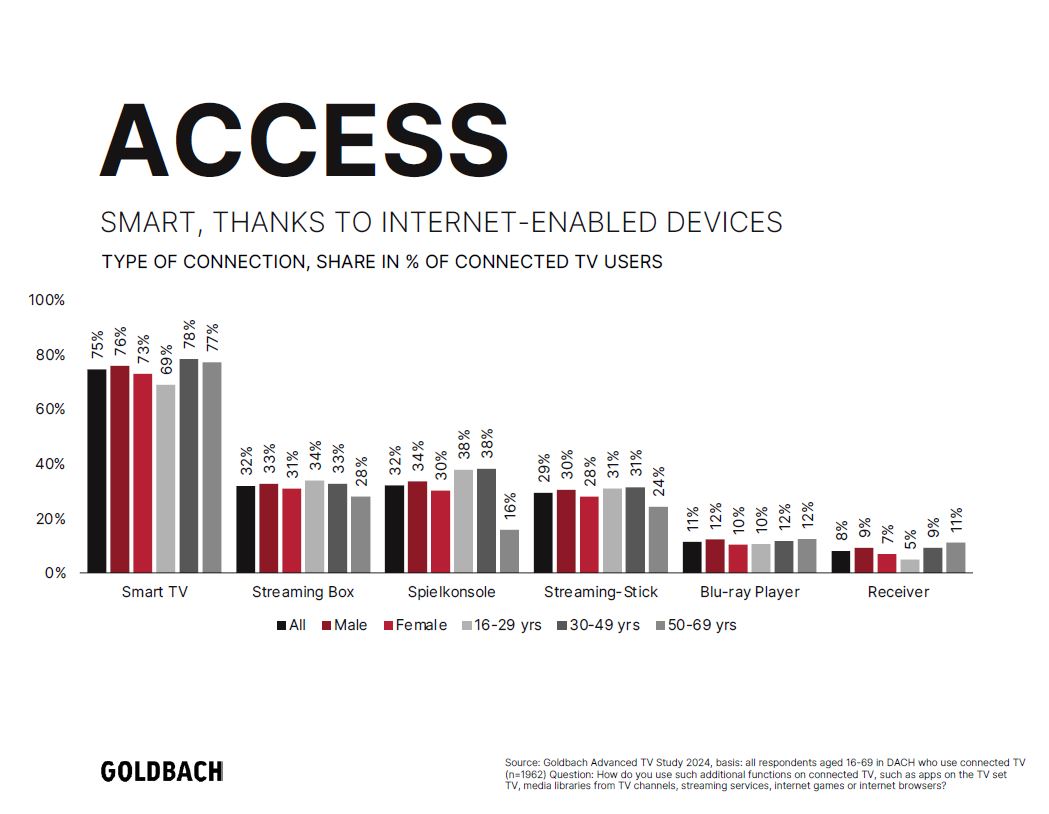 Source: goldbach.com
Source: goldbach.com2. Video consumption via streaming only is on the rise: Already 27% of users in the DACH region are cord-cutters
Two-thirds of respondents have at least one TV with an internet connection at home. Of these, 91% are also connected to the internet. Thanks to the connectivity, 52% of respondents start consuming programmes on the big screen via a device-specific user interface rather than in a running programme. 27% of respondents in the DACH region only use CTV to consume moving pictures on the big screen. These cord-cutters do not access via cable or satellite TV; instead, they stream video content via internet/web TV or IPTV.
3. Steady usage: 50% of people use CTV weekly, 25% daily
Half of respondents said they used CTV weekly, while a quarter of 16-69 year olds used CTV daily. People aged 16-49, households with three or more people and households with children developed a taste for this medium.
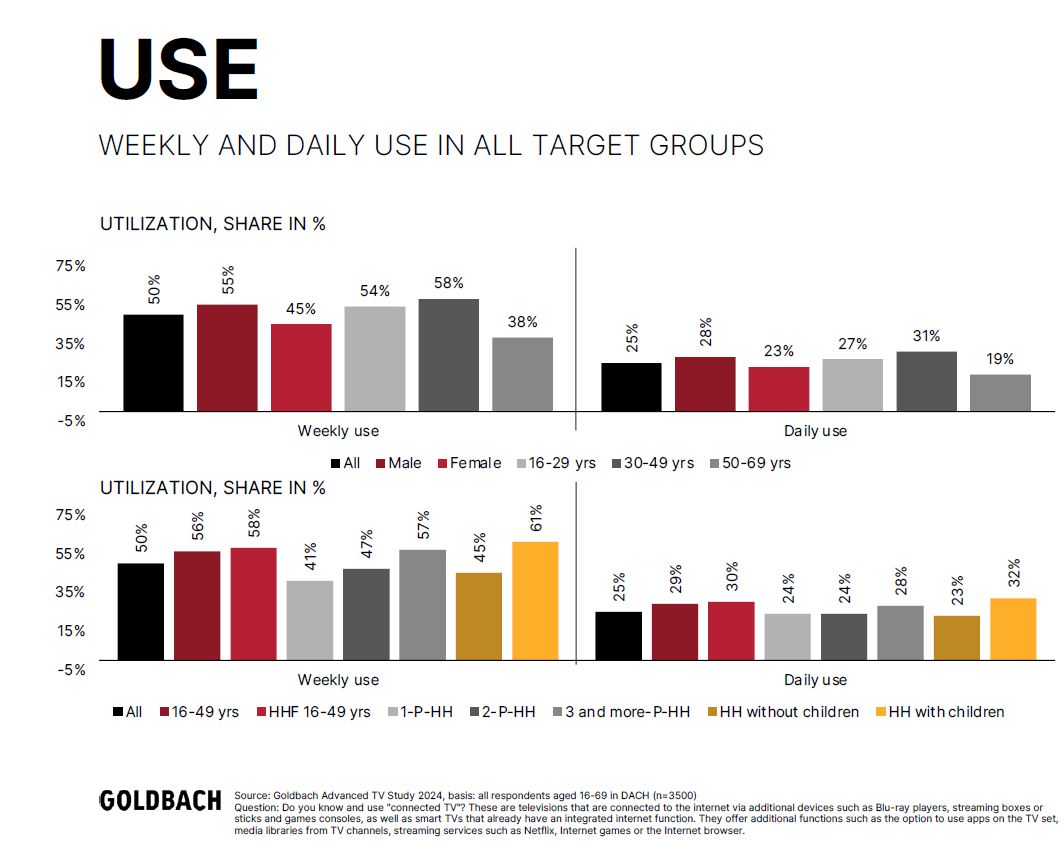 Source: goldbach.com
Source: goldbach.com4. Free content is preferred: Two-thirds of people accept advertising
CTV appeals to users with a large selection of content and a high degree of flexibility, as well as the opportunity to be their own “programming director”. Streaming apps are by far the most popular, followed by TV channels, music, and sports apps. Users generally prefer to use free apps over paid ones.
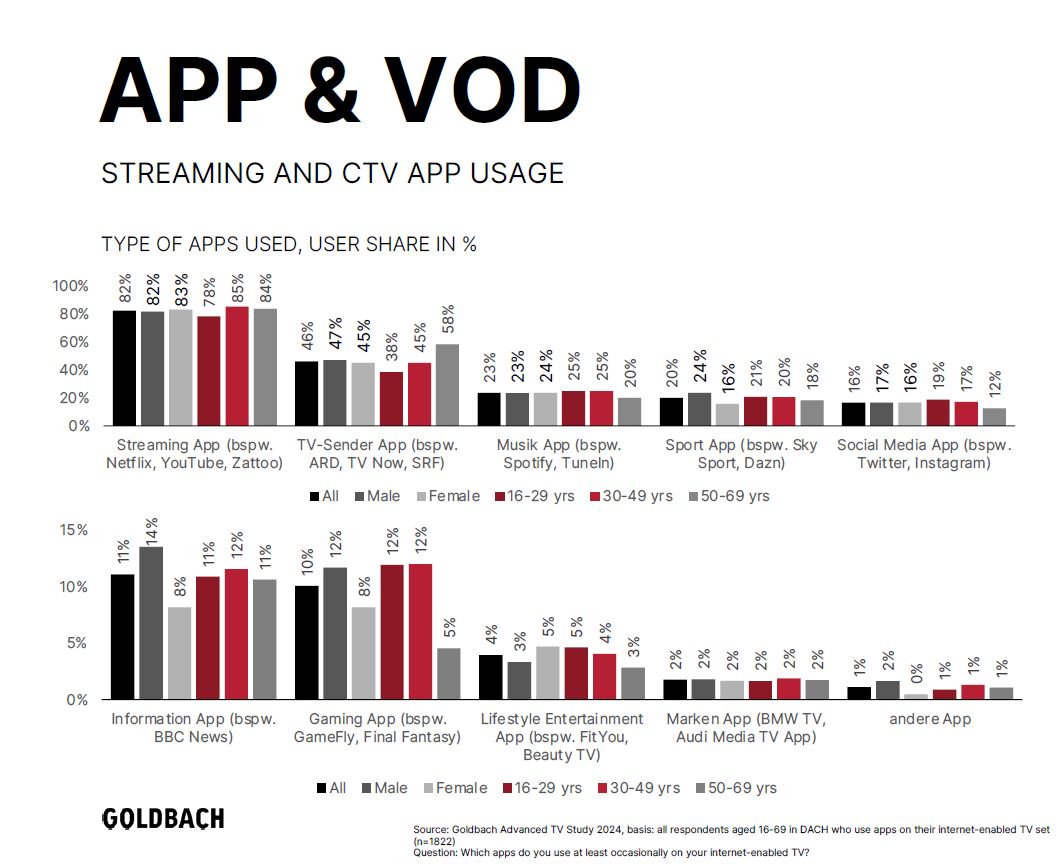 Source: goldbach.com
Source: goldbach.comTwo-thirds of users would also put up with advertising if they could watch content for free - this statement saw an increase from last year.
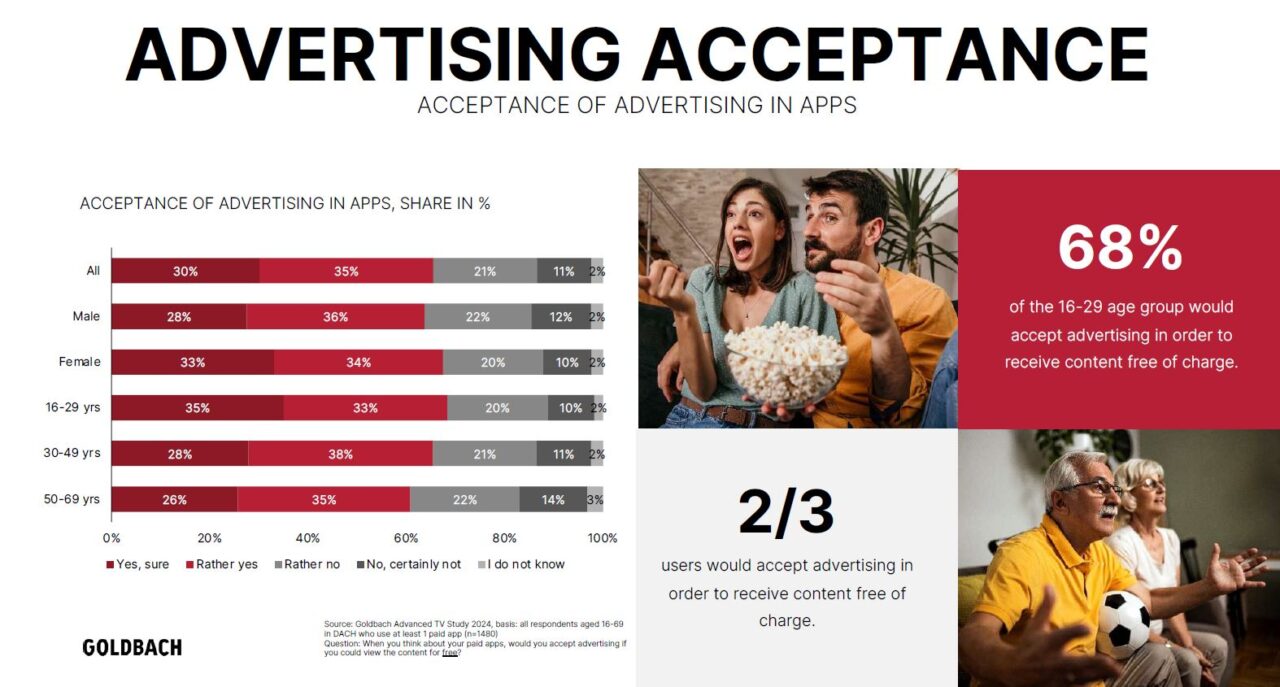 Source: goldbach.com
Source: goldbach.com5. Big potential for advertisers: CTV advertising is becoming more and more effective
Awareness of advertising in the connected TV environment increased by +10% (to 51%) year on year. Viewers aged 16-49 and households with children are particularly attentive. Acceptance of advertising is also increasing: 52% of respondents find advertising on CTV quite acceptable, almost 50% find it a source of useful information about new products, 40% find it useful and 37% find it informative.
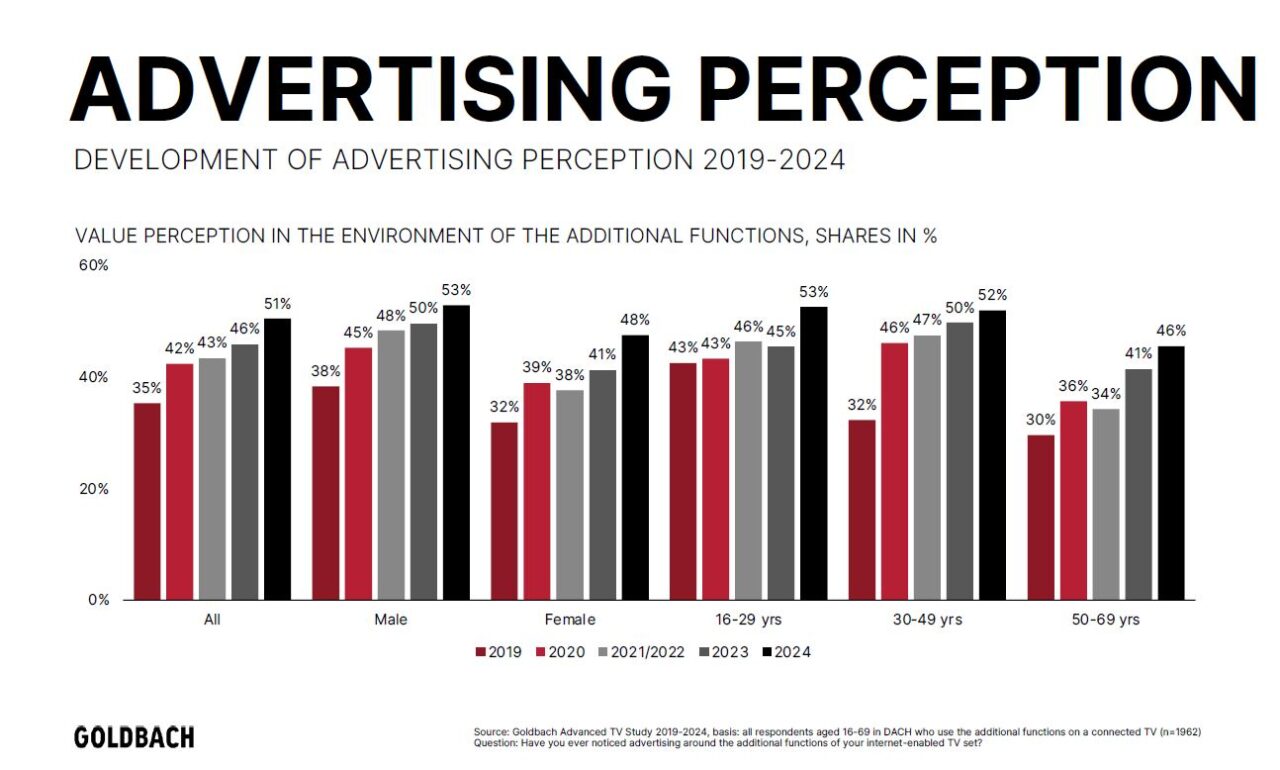 Source: goldbach.com
Source: goldbach.comThe recall rate is also quite high: 35% of respondents agree that they remember the CTV advertisement, and almost a third find out more information about the advertisement they have seen, talk about it with friends, or buy the product they have seen.
Regarding specific forms of advertising, i.e. CTV spots and CTV advertising, it is clear that more than half of the respondents are familiar with these two forms of advertising. For CTV spots, this was the response of 58% of respondents, and for CTV ads 52%. Perception of CTV spots is slightly more conscious (44%) than that of CTV advertisements (33%).
Detailed results of the study are available here.
Sources: goldgach.com, mountain.com
Source: https://www.screenvoice.cz/aktuality/ctv-vykazuje-vysokou-miru-vyuzivani-a-akceptace-reklamy-coz-je-pro-inzerenty-atraktivni-zjistila-nova-studie-goldbach/

